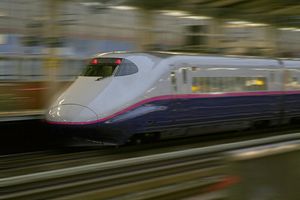India’s upcoming decision to adopt Japanese high-speed rail (HSR) system could be a threshold for railway diplomacy in South Asia.
New Delhi’s first HSR project of 505 km between Mumbai and Ahmedabad would operate with a Japanese HSR system at a top speed of 320 km/h. Such characteristics would likely be passenger-only services, because mixing freight trains with passenger lines would lower the operating speed due to greater friction on the tracks, potentially affecting the stability of the HSR train. The length of this line is in the optimal range, between 200 to 1000 km, in terms of competition with aviation and automobiles. About half of the expenditure will be met with the help of a Japanese loan.
Compared to Thailand’s two to four or perhaps more HSR lines in the following decade, and China’s massive HSR projects, India’s modest plans likely reflect financial, technological and political concerns. Most HSR lines run at a lost, and a major investment in several HSR projects carries considerable financial risk. Although the Indian middle class is expanding, the price of an HSR ticket may not be affordable or attractive for many passengers. Moreover, airlines – particularly budget carriers – can still compete in the 200-1000 km range. A HSR line between two commercial centers with strong business passenger volume is a relatively safe choice to deliver the financial results that will encourage subsequent projects.
Another factor is that India’s existing wide gauge (1.676 m) railway network still needs investment, and building new HSR systems may be less useful in many areas than upgrading the conventional railways. Moreover, the Indian railway industry has considerable capacity of its own, and with the help of foreign technologies can produce several types of locomotives with top speeds of 160 km/h or higher. With its industrial capacity, New Delhi may negotiate with Tokyo to build HSR locally in the future, if the first line does well.
On the other hand, the Indian wide gauge track has the potential to handle speeds of up to 160 or 200 km/h, without building a parallel system. So utilizing HSR technologies to upgrade the existing network is another possibility for New Delhi.
Finally, unlike its Thai and Chinese counterparts, the Modi administration must consider opposition challenges, as well as media and public opinions. Overly ambitious construction may invite criticism, as well as losses.
Despite its limited scale, this first HSR first project in South Asia augurs well for Japan’s rail diplomacy. In the short term, this deal offsets Japan’s previous failure in Indonesia, and an infrastructure project of this kind signifies a step forward in Japan’s relations with India. A long-term, Japanese HSR in India, whether an existing Shinkansen model or new design, will introduce a variety of technologies and related standards, including signal, blocking, brake and operational regulations, which will more or less determine the future development of the Indian railway network, irrespective of its takes the form of additional HSR lines or upgrading conventional ones.
Although HSR and conventional railway systems operate with their own standards and regulations, many technologies are compatible. For example, HSR switches that allow trains to pass at high speed can be used on conventional tracks to raise efficiency. Therefore, as long as the Indian railway network is improving and Japanese technologies are being introduced, the Japanese railway industry will benefit from the former’s demands.
In fact, New Delhi is promoting rail links with South Asia, based on its wide gauge track. Given Tokyo’s current cooperation with India, this trend may open a broader market for Japan. At any rate, with the need to have compatibility with the Japanese system and standards, along perhaps with intellectual property issues, Chinese or other competitors may find their opportunities in India’s HSR market constrained.
Yet India-Japan railway cooperation may face several challenges. First, Japan has to date exported its HSR only to the U.K. and Taiwan, with a project in Thailand still in the planning stage. The HSR system in Taiwan has survived the subtropical and tropical climate, but the environment in West India may be more testing, with its heat and humidity.
Second, New Delhi is aware of its own large demand and may look for alternative sources for HSR and other railway technologies, as it has done in military procurements, to give it better leverage and prevent a monopoly. Hence, its advantages aside, it is unclear just how much of the Indian HSR market Japan will ultimately secure.
Still, a Japanese HSR system in India is a milestone for both sides. Compared to deals in Taiwan, the U.K. and Thailand, this one in South Asia returns Japan’s railway industry to a continental context for the first time since 1945. If Tokyo can continue to develop its railway diplomacy in India or other continental states, more geopolitical significance is likely to occur.
As for New Delhi, building a HSR marks a new era for its land transportation. Although current projects are domestic, connections with neighboring countries is likely in the near future. In other words, HSR and other railway systems could become an Indian foreign policy tool in the foreseeable future. And after losing out in India, China may concentrate its own railway diplomacy on Bangladesh, not only to acquire a presence in South Asia but also to pave the way for another route in its One Belt, One Road strategy.
In short, rail diplomacy may become a significant new feature on the subcontinent.
Shang-su Wu is a research fellow in the Military Studies Programme, a constitute unit of the S. Rajaratnam School of International Studies (RSIS), Nanyang Technological University, Singapore.

































